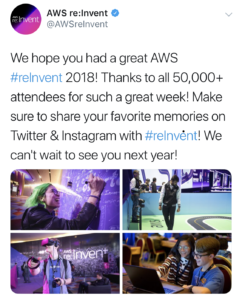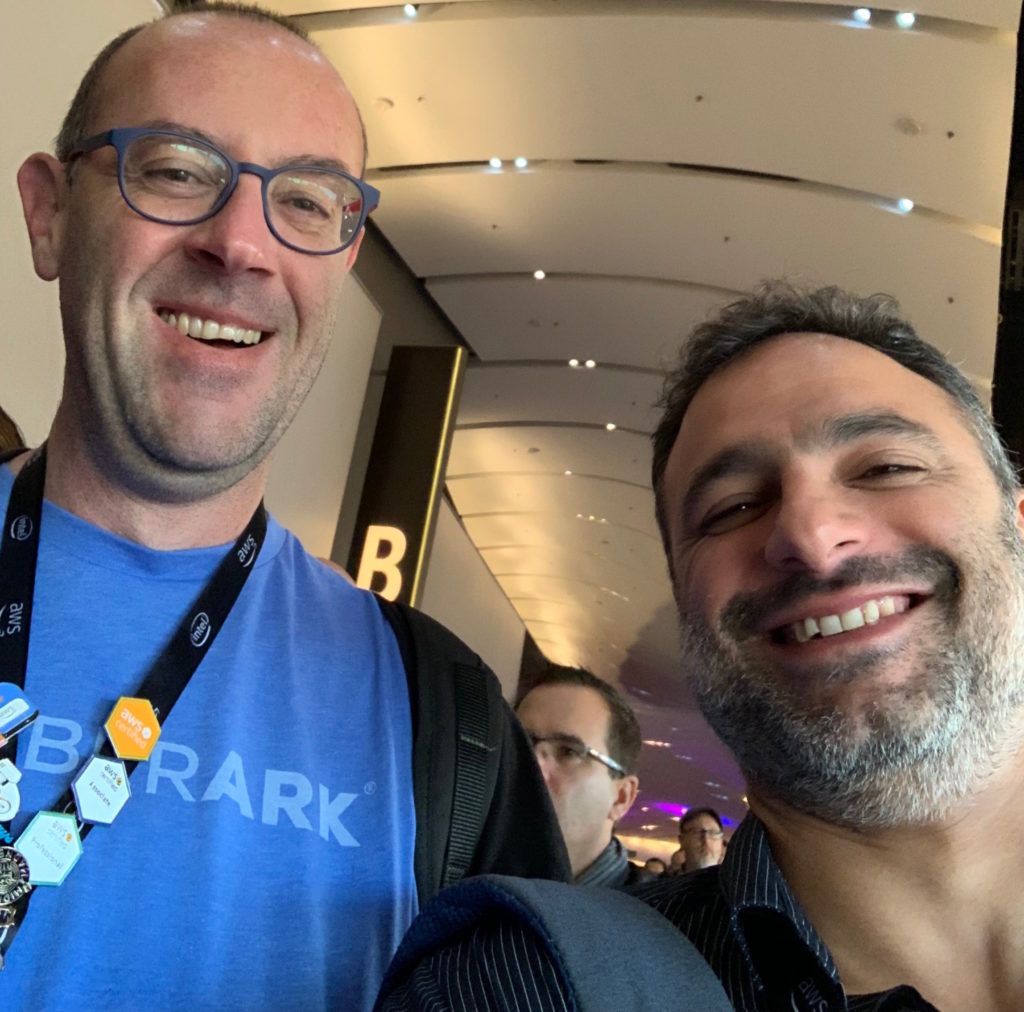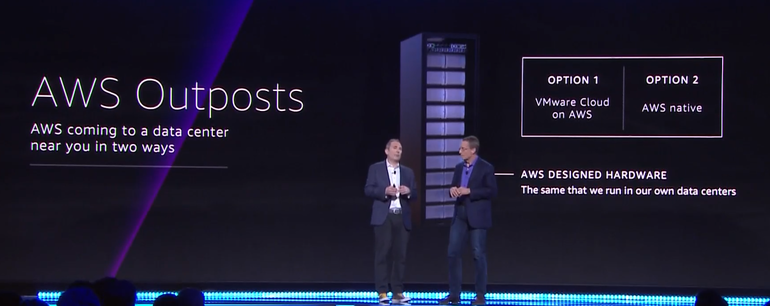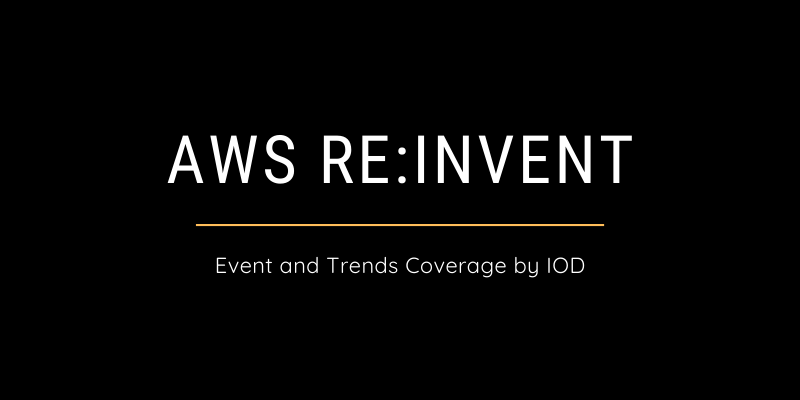Competing with Partners, the Cost of Cloud, and Looking Forward to the Next 7 Years
This was my 7th re:Invent.
Which, if you know your stuff or do some quick math, you’ve already figured out means I’ve been to all of them.
 Amazon organized the first re:Invent at the Venetian. Approximately 5,000 of us showed up. Seven years in, the number of attendees has grown to 50K+.
Amazon organized the first re:Invent at the Venetian. Approximately 5,000 of us showed up. Seven years in, the number of attendees has grown to 50K+.
Back then, I was with a startup called Newvem that was developing an advanced, comprehensive MongoDB-based analytics service that was supposed to help AWS users track and analyze utilization, while avoiding resource sprawl and waste. (This challenge still exists, as we all know.)
At that time, AWS had recently announced its partners program (APN). In the years since, Amazon’s ecosystem has multiplied exponentially and now the expo floor at re:Invent is filled with hundreds of vendors, making this event the largest one in the world of enterprise IT.
Last week, however, I kept hearing people talk about this notion of AWS competing with its partners — the inherent tone being that of confusion or resentment. But haven’t we already seen this tendency from AWS? Is our cloud ecosystem really any different now than it’s previously been?
AWS as Competition: Round 7
If you’ve been tracking Amazon’s cloud developments over the years, you’re probably not surprised by the fact that AWS competes with its partners. Certainly AWS appreciates its partners and has invested a lot in building a healthy, robust ecosystem that includes both professional services and ISVs (independent solution vendors).
Nonetheless, at each re:Invent, someone I know says, “Which partners will AWS kill at their keynote today?” Taking into account the announcement of Control Tower, and if you’re familiar with the vendors on the expo floor, you might say they indeed killed a few startups this year: Dome9, for instance, recently acquired by Checkpoint.
If you were to ask Zohar, the company’s founder (who I know well), I’m betting he might say with pride that for the last eight years, Dome9 knew this was a threat, but one that forced the company to exhibit a faster pace of innovation and demonstrate greater worth than any of their competition, including AWS. This type of “competition” is the Amazon culture and this is how a market survives and remains healthy.
 (On this topic, I would be remiss not to mention Intel, who must now also move fast to show they can keep up following the release of the ML inference chip designed by Annapurna Labs. But this would be a whole blog post on its own and I’m planning to cover that in more detail soon.)
(On this topic, I would be remiss not to mention Intel, who must now also move fast to show they can keep up following the release of the ML inference chip designed by Annapurna Labs. But this would be a whole blog post on its own and I’m planning to cover that in more detail soon.)
As it has over the years, Amazon will keep responding to the needs of its customers and will keep developing solutions that may “kill” its partners. But there is a greater challenge, a greater need, they still haven’t solved: Cost.
Cloud Management’s Biggest Headache Is Still Cost
I’ve covered the Amazon ecosystem and the APN program multiple times in the past, specifically analyzing how the solution vendor closes the gaps in enterprise cloud management, especially when it comes to security and availability. As mentioned above, AWS competes with its partners by closing these gaps themselves with new features, not even considering acquiring and integrating a solution.
That said, I argue that when it comes to the problem of managing costs, the land it still a green field. Even Amazon continues to struggle with providing the tools required to help their customers. Seven years ago, no one really paid close attention to the hundreds or thousands of dollars they spent. But today, with the maturity of the cloud consumer, cost is a significant trouble spot.
Today’s partner ecosystem includes solutions for cost management — companies like Cloudability, CloudCheckr, and CloudHealth, as well as a few others. AWS has its own tools, as well, including Cost Explorer and Trusted Advisor. But still these are not sufficient considering the fact that in order to truly save costs, you should not only view what’s going on, but also take actions— and not only shutting down and scaling down redundant resources.
During a podcast I was invited to, we got into a discussion on the topic of cost management. A system architect said his main goal is not to design new systems, but re-architect and figure out which new features will drive AWS costs down. These types of actions and decisions require experience, confidence, time, and money. How much will it cost to move to DynamoDB? And how much will it cost to run a specific a serverless function?
Considering that understanding costs comes with the need to learn the alternatives, this management aspect is still a pain point of public cloud that has yet to be solved. Moreover, when it comes to their bill, can cloud consumers — and should they — trust their cloud vendor to guide them through the decision process of which products to use and what is the more cost efficient architecture? There is a conflict of interest between vendor and consumer when it comes to cost.
This Intense Event Is a Microcosm of Our Fast-Paced Culture of Innovation
From November to November, I suppose I forget a little what it’s like to be at re:Invent. I keep with me an intellectual memory of the excitement, the pulse, the energy. But nonetheless, when I get there each year, I am always impressed to feel this energy anew.

The fact that this event has not gotten stale for me even after seven years illustrates how this giant of a vendor not only cares about their product, but also contributes to our hard-working and innovative culture. One way it does this is by pushing the ecosystem to its limits, competing with its vendors, and inviting users to be curious and be better trained on their cloud systems. re:Invent encompasses all that and more.
I gotta say though, I don’t envy the exhibitors. Running and manning a booth on the expo floor requires lot of resources and energy. Exhibiting at re:Invent is considered a major milestone that will hopefully support business growth for the year ahead. Planning and prep is a significant task, as is making sure everything runs smoothly every day, all day. Running demos, facilitating conversations, handing out swag. AWS professionals don’t have it much easier during the show. I have some very good friends responsible for activities during re:Invent, and for them, re:Invent is a 24/7 operation, that comes with a sleepless week, and a constant requirement to “perform.”
Then there are the IT professionals who came to the conference to learn. They arrive full of hope and energy, making sure they have a seat in all the hottest breakout sessions. They’ve mapped out their journey from workshop to workshop, from site to site all over campus, all in advance. Chat with them for just a short bit and you will hear how excited they got at specific announcements, such as the Managed Kafka Streams offering and the on-premise AWS servers, OutPosts.

Is the End Near?
According to the Torah (or the Old Testament), on the seventh day the creation of the world was complete. Thus, in many cultures and religions, the number seven represents “completeness.” So, essentially, the world was deemed perfect on the seventh day.
In this techcrunch roundup from earlier this week, Patrick Moorhead, founder and principal analyst at Moor Insights & Strategy, implies that AWS may soon reach the point where innovation is tapped out.
“As for the frenetic pace of innovation, Moorhead believes it can’t go on forever. ‘To me, the question is, when do we reach a point where 95 percent of the needs are met, and the innovation rate isn’t required. Every market, literally every market, reaches a point where this happens, so it’s not a matter of if but when.'”
I don’t believe we are anywhere near this point, but it’s interesting to consider that after almost a decade of innovating hard and fast, AWS may be nearing a slowing-down.
Is it so with AWS after seven re:Invents? Has AWS reached perfection? While I can totally understand where Moorhead is coming from, based on 10 years of tracking the pace and growth of AWS, what I have seen is that the market continues to evolve slowly (an evolution that still sees Oracle losing business to AWS). I believe there are at least 7 more years of “re:Invents” ahead, and by the end of the next decade, we will have seen a transformation of enterprise IT from the ground up. AWS and public cloud will play a significant role in this, if not the most significant role.
See you next November in Vegas!


